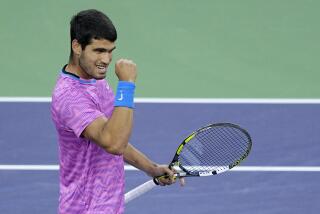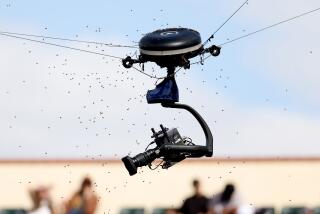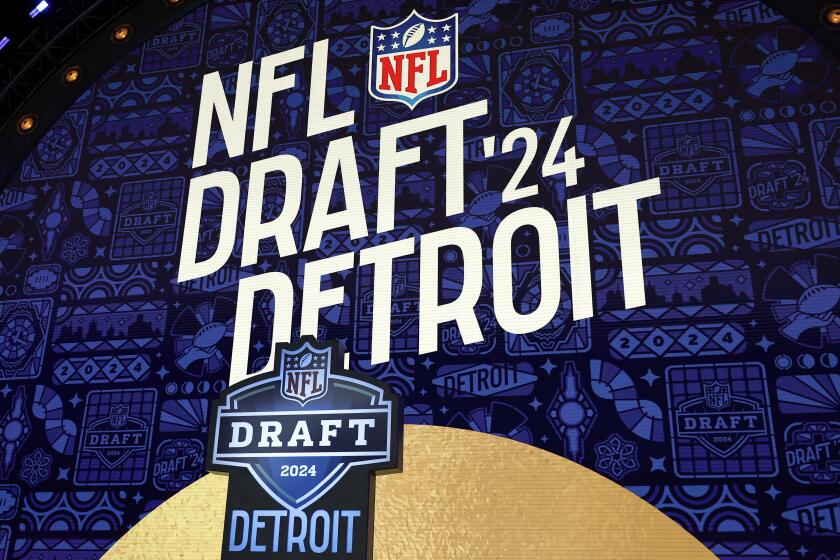Rafael Nadal-Roger Federer rivalry is aging but it’s still aces
They served a couple of nice appetizers to tennis fans Tuesday. A little caviar and Rafa, a little bruschetta and Roger. Yummy.
The main course, porterhouse certainly, is quite likely to come to this BNP Paribas Open in Saturday’s semifinals. If it happens, the Indian Wells Tennis Garden will be packed and poised to eat it up. Rafael Nadal and Roger Federer, together again.
Of course, their victories Tuesday merely got each man to the Round of 16. Plenty of tennis to play. Many bumps and turns remain possible.
But these two already legendary players have been joined at the hip by history for quite some time now, and like great rivals, they tend to find ways to find each other. They are the current tennis version of Magic and Bird, Ali and Frazier. They have had trailblazers in this rivalry thing in their own sport. Think McEnroe-Borg, Sampras-Agassi.
To Nadal and Federer, Tuesday was certainly routine. To tournament organizers and people with tickets for the semifinals, it was a gush of saliva.
Nadal played the No. 26 player in the world, Marcel Granollers, another Spaniard who either didn’t have the tools to resist much or was merely showing nationalistic respect. Granollers did the expected, going quickly in the final match of the day session, 6-1, 6-4.
Federer had a somewhat more interesting task. In the first match at night, he was playing No. 27, but a No. 27 on the rise, with weapons and a future. Milos Raonic is from Canada, and the last time that country had a home-grown tennis star was never. His ranking is already the best ever from the provinces north of the border and, at 21, he is the only player born in the ‘90s to have won an ATP Tour event.
In Canada, it’s enough to distract them from the great debate, oot and aboot, about hybrid icing. Holy Maple Leafs.
Raonic is 6 feet 4, serves huge bombs, such as the 120-mph second serve that won the first-set tiebreaker, and has as his idol Pete Sampras, who served a few bombs of his own in his time. Raonic is a St. Bernard, growing into his paws, and has yet to beat a top-eight player in seven tries. Federer was no different, rallying from the set-point, tiebreaker bomb to win, 6-7 (4), 6-2, 6-4.
Of course, Federer is pretty good about educating the middle-level players on the tour about respecting their elders. In his last 73 matches against players outside the top 20 in the world, No. 3 Federer has gone 73-0.
Nadal, of course, is not outside the top 20 and may never be again. He is No. 2, and as both he and Federer struggle to solve the sudden puzzle of No. 1 Novak Djokovic, they remain an incredible matchup, even if it is now more likely to occur in the semifinals than the final.
Federer is 30, Nadal 25. Federer started on the tour in 1999, Nadal in ’03.
Andy Roddick was asked about eras and legacies after one of his matches here and, among the things he said was that, even with their age and playing-time discrepancies, “Federer and Nadal will always be part of each other’s era.”
Federer has won a record 16 Grand Slam titles. To many, that is the measure of the greatest player ever. Nadal has won 10 majors, including six on the red clay at the French Open. To many, that makes him the most likely prospect to top Federer’s total.
Only seven men have won each of the four majors at least once. Federer and Nadal make the list, along with Don Budge, Fred Perry, Rod Laver, Roy Emerson and Andre Agassi.
But seldom have two players been so closely connected in the minds of fans. Seldom have two people spent such a huge chunk of their lives slugging fuzzy yellow balls across a net at each other.
They have played 27 times. Nadal has won 18. Of those 27 matches, 10 have been on the big stage of a Grand Slam, either in a semifinal or final. Breaking it down further, they have logged a total of 4,148 minutes on the court against each other, which is 69 hours 13 minutes. Their ’08 Wimbledon classic, won by Nadal, went 4 hours 48 minutes. Their 2007 Wimbledon classic, won by Federer, went 15 minutes shy of four hours.
They have drained every drop of energy from each other time after time and then had empathy for the loser during the victory ceremony. To this day, when Nadal is asked about any desire he might have to be considered the best player of all time, he always shakes his head and conveys the same message, in his delightful broken English: “Roger is the best.”
They tend to tread water in the early rounds, saying little, giving up little, waiting for the end, when it counts. But once in awhile, we get moments of spice.
Federer jabbed his friend and foe a little before the tournament started when asked about slow play. “I don’t know how to go through a four-hour match with Rafa and he never gets a violation.”
Nadal responded, “The rule [20 seconds between points] is there, but you cannot expect to play a six-hour match, play rallies with crazy points, and rest for 20 seconds.”
That exchange was something new, but it’s not as if either needs something to munch on before they go at it again.
More to Read
Get our high school sports newsletter
Prep Rally is devoted to the SoCal high school sports experience, bringing you scores, stories and a behind-the-scenes look at what makes prep sports so popular.
You may occasionally receive promotional content from the Los Angeles Times.







